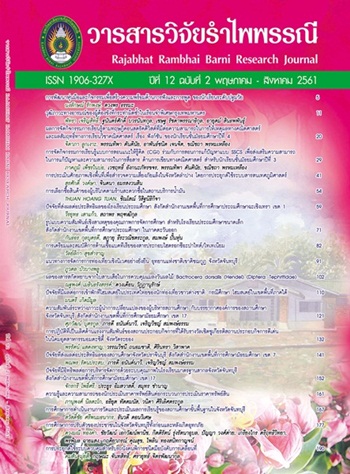ผลของสารสกัดหยาบจากใบสาบเสือในการควบคุมแมลงวันผลไม้ Bactrocera dorsalis (Hendel) (Diptera: Tephritidae)
Main Article Content
บทคัดย่อ
การทดสอบประสิทธิภาพสารสกัดหยาบจากใบสาบเสือที่สกัดด้วยเอทานอล ในการเป็นสารไล่ สารฆ่าและสารยับยั้งการเจริญเติบโตของแมลงวันผลไม้ ที่ระดับความเข้มข้น 0, 0.5, 1, 2, 4 และ 8% (w/v) วางแผนการทดลองแบบสุ่มสมบูรณ์ (completely randomized design; CRD) ความเข้มข้นละ 5 ซ้ำ ซ้ำละ 10 ตัว ทำการทดลองที่ห้องปฏิบัติการชีววิทยา ผลการทดลองพบว่าประสิทธิภาพของสารสกัดหยาบจากใบสาบเสือมีผลต่อการไล่ การฆ่า และการยับยั้งการการเจริญเติบโตของแมลงวันผลไม้มีความแตกต่างกันอย่างมีนัยสำคัญที่ระดับความเชื่อมั่น 95% เมื่อเปรียบเทียบกับชุดควบคุม ที่ความเข้มข้น 8% มีประสิทธิภาพในการเป็นสารไล่ตัวเต็มวัยแมลงวันผลไม้สูงสุด โดยในชั่วโมงที่ 12 มีผลต่อการไล่ตัวต็มวัยแมลงวันผลไม้เฉลี่ย 9.60 + 0.48 ตัว คิดเป็นเปอร์เซ็นต์การไล่ 92% และในชั่วโมงที่ 24 มีผลต่อการไล่ตัวเต็มวัยแมลงวันผลไม้สูงสุดเฉลี่ย 10.00 + 0.00 ตัว คิดเป็นเปอร์เซ็นต์การไล่ 100% ในการเป็นสารฆ่าที่ความเข้มข้น 8% มีเปอร์เซ็นต์การตายของหนอนแมลงวันผลไม้สูงสุดเฉลี่ย 7.60 + 0.74 ตัว คิดเป็นเปอร์เซ็นต์การตาย 76% ค่า LC50 เท่ากับ 36.34% ในชั่วโมงที่ 24 และ 10.00 + 0.00 ตัว คิดเป็นเปอร์เซ็นต์การตาย 100% ค่า LC50 เท่ากับ 23.28% ในชั่วโมงที่ 48 นอกจากนี้ที่ความเข้มข้น 0.5% ระยะดักแด้มีเปอร์เซ็นต์การตาย 25% เมื่อเปรียบเทียบกับชุดควบคุมระยะดักแด้ไม่มีเปอร์เซ็นต์การตาย ระยะเวลาในการพัฒนาเจริญเติบโตเป็นระยะดักแด้และตัวเต็มวัยใช้เวลาเฉลี่ย 12.50 + 0.47 และ 7.40 + 0.47 วัน ตามลำดับ ในขณะที่ชุดควบคุมระยะเวลาในการพัฒนาเจริญเติบโตเป็นระยะดักแด้และตัวเต็มวัยใช้เวลาเฉลี่ย 7.20 + 0.47 และ 12.50 + 0.47 ตัว ตามลำดับ
Article Details
เอกสารอ้างอิง
2. Agaba, T.A and B. Fawole. (2016). Phytochemical Constituents of Siam Weed (Chromolaena odorata) and African Custard Apple (Annona senegalensis). Int. J Food Agri. Vet. Sc. 6(1): 35-42.
3. Ali, H., S. Ahmad., G. Hassan., A. Amin., Z. Hussain and M. Naeem. (2011). Bioefficacy of Different Plant Extracts against Melon Fruit Fly in Bitter Gound. Pak. J. Weed Sci. Res. 17(2): 143-149.
4. Azad, M.A.K. (2012). Effect of Botanical Extract on Pest Control in Brinjal Field. J. environ sci and nat resources. 5(2):173–176.
5. Chakraborty, A.K., S. Rambhade and U.K Patil. (2011). Chromolaena odorata (L.): An Overview. J Pharm Res. 4(3): 573-576.
6. Dey, K.R., P. Choudhury and B.K. Dutta. (2013). Impact of pesticide use on the health of farmers: A study in Barak valley, Assam (India). J. Environ Chemist and Ecotox. 5(10): 269-277.
7. Finney, D.J. (1971). Probit Analysis, 3rd ed., Cambridge University Press: London.
8. Haider, H., S. Ahmed and R.R. Khan. (2011). Determination of level of insecticide resistance in fruit fly, Bactrocera zonata (Saunders) (Diptera: Tephritidae) by bait bioassay. Int. J. Agri and Bio. 13: 815–818.
9. Isman M.B. (2000). Plant essential oils for pest and disease management. Crop Protect. 19: 603-608.
10. Isenring, R. (2010). Pesticides reduce biodiversity. Pesticides News. 88: 4-7.
11. Jagruti H.S., H. Kumar., M.H.S. Godinho and A. Kumar. (2014). Larvicidal activity of methanolic leaf extracts of plant, Chromolaena odorata L. (Asteraceae) against vector mosquitoes. Int. J. Mosquito Res. 1(3): 33-38.
12. Jayanthi, P.D.K., V. Kempraj, M.A. Ravindra and A. Verghese. (2015). Oriental fruit fly, Bactrocera dorsalis (Hendel) infestation makes banana crop vulnerable to Indian blue peafowls attack. Pest Manage in Horticul Eco. 21(1): 88-89.
13. Kaur, A., S.K. Sohal., R. Singh and S. Arora. (2010). Development inhibitory effect of Acacia auriculiformis extracts on Bactrocera cucurbitae (Coquillett) (Diptera: Tephritidae). J. Biopest. 3(2): 499-504.
14. Khan, S., M.M. Shah., R. Ahmad and H.A.Q. Ihsan ul. (2016). The insecticidal potential of botanical extracts for management of Peach fruit fly, Bactrocera zonata Saunders, 1842 (Diptera: Tephritidae). Türk. entomol. derg. 40(4): 445-453.
15. Lall, D., S. Summerwar and J. Pandey. (2014). Bioefficacy of Plant Extracts Against Larvae of American Bollworm Helicoverpa armigera (Noctuidae: Lepidoptera) Special Reference to the Effect on Peritrophic Membrane). Int. Conference Chem, Civil and Environ Engineer (CCEE’2014). Nov 18-19, Singapore. 21-23.
16. Nadeem, M.K., S. Ahmed., S. Nadeem., M. Ishfaq and M. Fiaz. (2014). Assessment of Insecticides Resistance in Field Population of Bactrocera zonata (Saunders) (Diptera: Tephritidae). J. Animal & Plant Sciences. 24(1): 172-178.
17. Prabhakar, C.S., P. Sood and P.K. Mehta. (2012). Pictorial keys for predominant Bactrocera and Dacus fruit flies (Diptera: Tephritidae) of north western Himalaya. Arthropods. 1(3): 101-111.
18. Prakash, A., J. Rao., V. Nandagopal. (2008). Future of Botanical Pesticides in rice, wheat, pulses and vegetables pest management. J. Biopest. 1(2):154–169.
19. Rajmohan, D and K. Logankumar. (2011). Studies on the insecticidal properties of Chromolaena odorata (Asteraceae) against the life cycle of the mosquito. J. Res Bio. 1(4): 253-257.
20. Rehman, J.U., G. Jilani., M.A. Khan., R. Masih and S. Kanvil. (2009). Repellent and Oviposition Deterrent Effects of Indigenous Plant Extracts to Peach Fruit Fly, Bactrocera zonata Saunders (Diptera: Tephritidae). Pakistan J. Zool. 41(2): 101-108.
21. Thakur, M and D. Gupt. (2013). Plant Extracts as Oviposition Deterrents against Fruit Flies, Bactrocera spp. Infesting Vegetable Crops. Pest Res Journal. 25(1): 24-28.
22. Sarwar, M and M. Salman. (2015). Insecticides Resistance in Insect Pests or Vectors and Development of Novel Strategies to Combat Its Evolution. Int. J. Bioinf and Biomed Engineer. 1(3): 344-351.
23. Siddiqi, A.R., A. Rafi., F. Naz., R. Masih., I. Ahmad and G. Jilani. (2011). Effects of Curcuma longa extracts on mortality and fecundity of Bactrocera zonata (Diptera: Tephritidae). Ciência e Prática. 35(6): 1110-1114.
24. Verghese, A., P.L. Tandon and J.M. Stonehouse. (2004). Economic evaluation of the integrated management of the oriental fruit fly Bactrocera dorsalis (Diptera: Tephritidae) in mango in India. Crop Protect. 23: 61–63.
25. Zhou B.G., S. Wang., T.T. Dou., S. Liu., M.Y. Li., R.M. Hua., S.G, Li and H.F. Lin. (2016). Aphicidal Activity of Illicium verum Fruit Extracts and Their Effects on the Acetylcholinesterase and Glutathione S-transferases Activities in Myzus persicae (Hemiptera: Aphididae). J. Insect Science. 16(1): 1–7.


